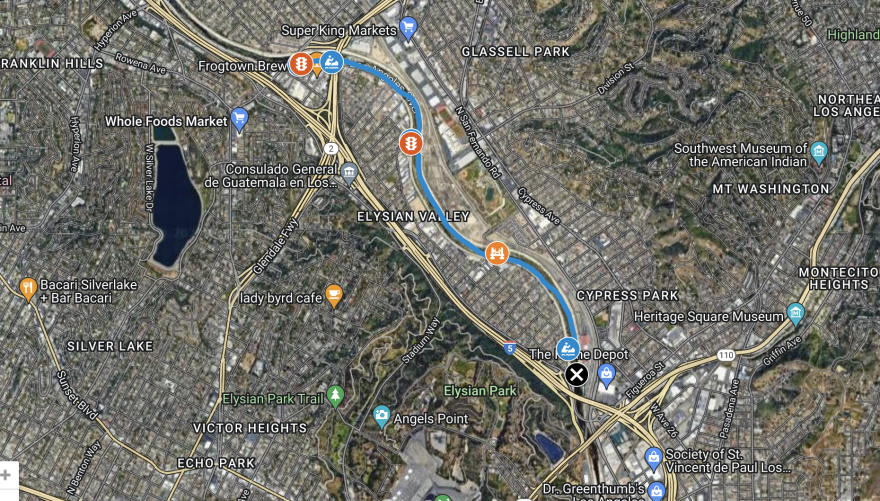With our free press under threat and federal funding for public media gone, your support matters more than ever. Help keep the LAist newsroom strong, become a monthly member or increase your support today.
LA River Now Open For Kayaking, Fishing And Walking (Just Check The Water Quality First)

In recent years, the Memorial Day opening of the L.A. River Recreation Zones has become an unofficial marker of summer.
Folks can walk, fish, birdwatch, and kayak down parts of the Elysian Valley (east of the 5 Freeway), and the Sepulveda Basin (in the west San Fernando Valley).

This summer you can also use the new pedestrian and bicycle bridge, Taylor Yard Pedestrian and Bicycle Bridge, which connects the Elysian Valley and Cypress Park neighborhoods. It opened as part of the L.A. River revitalization project in March.
LA bridge Twitter update: not sure if the Taylor Yard bridge is officially open, but you can now cross it fully pic.twitter.com/Or50aDSGkX
— dan faughnder (@danfaughnder) January 22, 2022
Councilmember Mitch O'Farrell says that the river zones aim to connect L.A. residents "back" to the river, which served as "the foundation of the city."
"It's such an incredible feeling and to see people hike the river for the first time," he added. "It's almost like seeing a child at an amusement park because it's just so fun and different. People connect immediately with what nature can be in an urban environment."
One caveat — if you do venture out kayaking — watch out for the quality of the water. Solar-powered water quality lights stationed at the kayaking entry points show green, yellow and red, warning folks when to avoid the river entirely.
Fernando Gomez with the Mountains Recreation and Conservation Authority says as a general rule, people shouldn't touch or drink the water. If water comes in contact with your eyes or mouth, he advises washing it out.
If you're interested in learning more about the controversial history of the L.A. River, check out our in-depth coverage of the subject.
Is it a river? A sewer? A flood control channel? A place to film awesome drag racing scenes? A tool of gentrifiers to raise property values? What's the deal with the L.A. River, and why should I care about it? Let's find out.
Read: LA Explained: The Los Angeles River
At LAist, we believe in journalism without censorship and the right of a free press to speak truth to those in power. Our hard-hitting watchdog reporting on local government, climate, and the ongoing housing and homelessness crisis is trustworthy, independent and freely accessible to everyone thanks to the support of readers like you.
But the game has changed: Congress voted to eliminate funding for public media across the country. Here at LAist that means a loss of $1.7 million in our budget every year. We want to assure you that despite growing threats to free press and free speech, LAist will remain a voice you know and trust. Speaking frankly, the amount of reader support we receive will help determine how strong of a newsroom we are going forward to cover the important news in our community.
We’re asking you to stand up for independent reporting that will not be silenced. With more individuals like you supporting this public service, we can continue to provide essential coverage for Southern Californians that you can’t find anywhere else. Become a monthly member today to help sustain this mission.
Thank you for your generous support and belief in the value of independent news.

-
What do stairs have to do with California’s housing crisis? More than you might think, says this Culver City councilmember.
-
Yes, it's controversial, but let me explain.
-
Doctors say administrator directives allow immigration agents to interfere in medical decisions and compromise medical care.
-
The Palisades Fire erupted on Jan. 7 and went on to kill 12 people and destroy more than 6,800 homes and buildings.
-
People moving to Los Angeles are regularly baffled by the region’s refrigerator-less apartments. They’ll soon be a thing of the past.
-
Experts say students shouldn't readily forgo federal aid. But a California-only program may be a good alternative in some cases.







